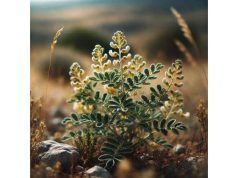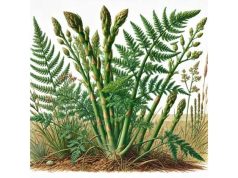
Alkanet is the common name for several related flowering plants within the borage family (Boraginaceae). Often, this term refers specifically to Alkanna tinctoria (dyer’s alkanet) or Anchusa officinalis (common bugloss) in colloquial usage—though the species Alkanna tinctoria is especially recognized for its deep red root that yields a vibrant dye. Originating in the Mediterranean region and parts of Western Asia, Alkanet has a storied legacy that merges natural dye production, folk medicine applications, and cosmetic use. Its modest height, bright green, lance-shaped leaves, and small, bluish-purple flowers belie the remarkable color hidden within its root. Historically, craftspeople prized Alkanet’s root for coloring oils, ointments, and fabrics, while herbalists praised its potential anti-inflammatory and wound-healing properties.
From ancient Persia and Greece to medieval Europe, Alkanet’s vivid pigment and mild medicinal reputation shaped how cultures harnessed this unassuming herb. Modern research, though limited, highlights some intriguing phytochemicals—particularly alkannins—and suggests moderate antibacterial, anti-inflammatory, and antioxidant activity. Still, caution is warranted: Alkanet is used more for external coloring and supportive topical remedies than for internal consumption, and certain species in the Boraginaceae family can contain pyrrolizidine alkaloids that pose health risks. This comprehensive article examines Alkanet’s botanical identity, storied past, beneficial constituents, and best practices for safe usage.
- Distinctive red root dye historically employed in cosmetics, textiles, and soaps
- Possible mild anti-inflammatory and wound-healing effects when applied externally
- Traditional usage in herbal salves, tinctures, or oils for skin irritations
- Potential antibacterial properties linked to alkannin compounds
- Caution for potential toxicity concerns if ingested in large amounts
Table of Contents
- Alkanet: Key Botanical Characteristics and Identification
- Alkanet: Cultural Importance and Historical Footprint
- Alkanet: Main Chemical Compounds and Active Principles
- Alkanet: Potential Benefits and Recognized Properties
- Alkanet: Practical Applications, Preparations, and Safety Measures
- Alkanet: Significant Studies and Emerging Research
- Alkanet: Frequently Asked Questions
Alkanet: Key Botanical Characteristics and Identification
Taxonomy and Related Species
- Family and Genus:
Alkanet generally refers to plants within the Boraginaceae family, especially those in the genera Alkanna or Anchusa. Alkanna tinctoria (dyer’s alkanet) is the species historically used for dyeing, while Anchusa officinalis is commonly dubbed “alkanet” or “bugloss.” - Species Variation:
- Alkanna tinctoria: Renowned for its root-based red pigment.
- Anchusa officinalis: Known as common bugloss or just “alkanet” in some herbal references, sporting bright purple-blue flowers.
- Other genera in the borage family—like Lithospermum—may share morphological traits but differ in usage.
Distinguishing Morphological Traits
- Stature and Stems:
- Dyer’s alkanet grows roughly 30–50 cm (1–1.5 ft) in height. The plant often appears somewhat bristly, with stems that may branch near the base.
- Common bugloss can reach up to 60 cm or more, featuring stiff hairs along stems and leaves.
- Leaves:
- Typically lanceolate or elliptical, covered in fine, rough hairs.
- The basal leaves can be broader, becoming narrower as they ascend the stem.
- Flowers:
- Small, tubular, and arranged in coiling inflorescences known as “scorpioid cymes,” typical of the borage family.
- Colors can vary from vibrant blue or purple (anchusa) to pinkish-lilac (some Alkanna species).
- Root System and Color:
- Alkanna tinctoria has a distinctive root with a crimson, resinous interior. Historically prized for dye extraction, which can range from red to purple depending on the medium.
Ecological Distribution
- Native Range:
- Dyer’s alkanet thrives in the Mediterranean region, southwestern Asia, and parts of North Africa.
- Anchusa species can appear across Eurasia’s temperate climates, populating meadows, roadsides, or disturbed soils.
- Cultivated vs. Wild:
- Some artisans grow Alkanet intentionally for dye production. Others might gather wild specimens, though caution is advised to ensure correct species identification.
Growth Requirements and Habitat
- Soil Preference:
- Prefers well-drained, sandy or loamy soils with moderate organic content.
- Tolerates somewhat calcareous or rocky ground.
- Light and Water:
- Full sun to partial shade fosters healthy growth.
- Moderately drought-tolerant once established; consistent moisture aids root development but avoid waterlogging.
- Propagation and Maintenance:
- Seeds can be started in spring, requiring sunlight for germination.
- Minimal fertilization is needed if grown for dye, as overly fertile soil might reduce root pigment intensity.
Thus, Alkanet’s botanical identity and morphological markers revolve around bristly leaves, modest upright growth, and a distinctive red root in the case of Alkanna tinctoria. Recognizing these traits ensures accurate identification, crucial for safe usage and consistent dye or herbal results.
Alkanet: Cultural Importance and Historical Footprint
From ancient textile dyes to medieval cosmetics, Alkanet’s deep red hue has woven itself through various cultures and epochs, bridging aesthetic endeavors with folk medicine practices.
Antiquity and Early Dye Traditions
- Egyptian and Mesopotamian Traces:
- While not definitively confirmed, some historians propose that red-hued dyes from Alkanna tinctoria could have been used in Middle Eastern or Mediterranean textiles and cosmetics.
- Ancient apothecaries might have recognized the root’s coloring potential for ointments or lip salves.
- Greek and Roman Usage:
- Possible references exist in classical texts describing “anchusa” or “ancusa,” referencing a red dye from the root used to color wool or even as a blush by Roman ladies.
- Apuleius, Pliny the Elder, or Dioscorides may hint at the root’s external applications, though exact species identification can be fuzzy.
Medieval and Renaissance Europe
- Cosmetics and Pigments:
- Alkanet root became a go-to for coloring salves, lip balms, and rouge-like cosmetics. The infusion in oils gave a lush red hue prized by noblewomen.
- Illuminated manuscripts might have used extracts for certain shades, though not as prevalent as woad or madder.
- Herbal Reputation:
- While overshadowed by more prominent herbs like sage or rosemary, Alkanet occasionally surfaced in herbal manuscripts for mild wound care or as a coloring agent in medicinal balms.
- Middle Eastern trades likely disseminated processed alkanet root across European markets.
19th–20th Century Shifts
- Industrial Dye Competition:
With synthetic dyes emerging in the 19th century, Alkanet’s role as a commercial dye waned. - Niche Cosmetic Use:
A remainder persisted in artisanal lipstick or rouge production, especially among small-scale crafters seeking natural colorants.
Global Folk Traditions
- Middle Eastern Soaps and Beauty:
- Alkanet root occasionally tinted homemade soaps or hair oils. Its ability to yield shades from rose to deep burgundy added flair to personal care routines.
- Indian Subcontinent:
- Although overshadowed by henna and turmeric for color, certain local traditions might incorporate Alkanet in herbal remedies for external uses.
Modern Revival
- Craft Artisans:
- Contemporary interest in “natural dyes” sees Alkanet root valued by DIY soap-makers, crafters, or natural cosmetic lines.
- Shades can vary from bluish-lavender to deep red, influenced by pH levels in mediums (oil, alcohol, vinegar).
- Herbal Education:
- Growing popularity of herbal schools reintroduces Alkanet’s historical uses, with caution around possible irritants or confusion among Boraginaceae species.
In essence, Alkanet’s role as a colorant overshadowed its modest medicinal renown across centuries. Though never a mainstream curative, it remains a testament to the synergy of color and healing in old-world traditions. Modern crafters, historians, and herbal enthusiasts keep the legacy alive, reflecting a dynamic continuity from antiquity to new artisanal pursuits.
Alkanet: Main Chemical Compounds and Active Principles
While Alkanet’s claim to fame is primarily as a coloring agent, the plant harbors an assortment of bioactive compounds, influencing both its hue and potential healing properties.
Alkannins and Shikonins
- Alkannin:
- The signature compound in Alkanna tinctoria root, responsible for the distinctive red pigment.
- Exhibits notable antimicrobial and anti-inflammatory activity in laboratory studies, fueling interest in topical formulations.
- Shikonin (in related species):
- A structural analog found in some Boraginaceae relatives, also associated with strong coloration and mild medicinal properties.
Other Phenolic and Triterpenoid Constituents
- Phenolic Acids (Caffeic, Rosmarinic, etc.):
Potential antioxidant, anti-inflammatory, or antimicrobial effects. Found in small amounts, overshadowed by alkannin. - Triterpenoids:
Appear in minimal concentrations, possibly lending slight anti-inflammatory or protective roles for the plant itself.
Volatile Compounds
- Essential Oils:
- Alkanet root typically lacks a strongly aromatic essential oil. Any fragrance is mild, overshadowed by the intense pigment.
- Resins and Waxes:
- Contribute to the root’s resinous texture, essential for the color extraction process.
Pyrrolizidine Alkaloids Concern
- Boraginaceae Family Risk:
- Certain species in the Borage family can produce pyrrolizidine alkaloids (PAs), toxic in high doses. However, documented presence of PAs in Alkanna tinctoria is less conclusive than in comfrey or borage.
- Overconsumption or misuse might lead to potential liver toxicity, reinforcing caution with internal intake, especially from root extracts.
Color Chemistry and pH Reactivity
- pH-Dependent Hue:
- Alkannin’s color can shift from red to purple or blue based on the alkalinity or acidity of the solution. This phenomenon is exploited in natural soapmaking or cosmetic product formulations.
- Solvent Influence:
- Alcohol, oil, or alkali solutions alter color intensity, giving crafters and herbalists creative leeway in product design.
Nutritional and Mineral Content
- Leaves vs. Root:
- Typically overshadowed by the root’s coloring pigments. Leaves and stems contain minimal vitamins or minerals, not widely used for nutrition.
- Root Composition:
- Predominantly specialized in pigment and resinous compounds, lacking significant macronutrient content.
Laboratory Extract Standards
- Extraction Methods:
- Soaking the root in oil or alcohol is a common practice to isolate alkannin. Ethanol or oil-based solutions yield deeper red color.
- Stability:
- Alkannin can degrade upon prolonged exposure to high heat or direct sunlight. Proper storage extends the shelf life of dyed or extracted products.
Hence, Alkanet’s phytochemical identity gravitates around alkannin’s powerful pigment, supplemented by modest antibiotic or anti-inflammatory attributes. This composition sets the stage for the herb’s cosmetic popularity and potential external therapeutic uses, while internal usage remains less common due to safety questions around boraginaceous alkaloids.
Alkanet: Potential Benefits and Recognized Properties
Though not as famous for medicinal power as some herbs, Alkanet’s unique colorant and mild healing capacity open multiple avenues for usage—particularly topical. Here are the more notable attributes historically attributed to Alkanet:
1. Skin Soothing and Wound Care
- Anti-inflammatory and Antibacterial Action:
- Alkannin extracts exhibit moderate bacteriostatic or fungistatic properties in some lab tests. This might promote better healing environments for minor cuts or abrasions.
- Traditional ointments use Alkanet oil as a base, believed to reduce redness and mild itching.
- Dermatological Cosmetics:
- Alkanet root-infused oil can serve as a gentle emollient for dry or irritated skin, delivering subtle pinkish hues to lip balms or lotions.
- The coloring effect is more aesthetic, though minor protective effects might come from the plant’s antioxidant content.
2. Natural Dye for Crafts and Cosmetics
- Color Variation in Soaps and Balms:
- The root’s deep red color can produce anything from pale lavender to dark burgundy in soaps, salves, or lip gloss, depending on pH.
- Favored in homemade cosmetic lines for a natural alternative to synthetic dyes.
3. Mild Anti-Inflammatory or Pain Relief
- Folk Medicine:
- Past usage recommended Alkanet-based poultices or salves on sprains, bruises, or arthritic joints.
- The effectiveness remains largely anecdotal, although minor analgesic effects may be connected to alkannin’s anti-inflammatory potential.
4. Minimal Internal Applications
- Historically cited for “coughs” or “fevers”:
- Some medieval herbals suggested Alkanet teas or syrups. Today, such use is rare, overshadowed by potential toxicity concerns.
- Caution is paramount if one contemplates internal ingestion, given the risk of possible PAs or unknown interactions.
5. Hair and Cosmetic Coloring
- Natural Red or Purple Tones in Hair Dyes:
- Some herbal hair dye formulations include Alkanet root to impart a subtle violet or burgundy tint.
- Typically used in combination with henna, amla, or other herbal colorants, though results can be inconsistent depending on hair porosity.
6. Spiritual or Symbolic Connotations
- Historically in Alchemy:
- The red root might have been connected to transformations or illusions in alchemical lore, though less documented than the more iconic plants.
- Artistic Symbolism:
- Red as a color of vitality or passion might tie into early spiritual or cultural rituals, but references are scattered.
Balancing Reality with Tradition
- Limited Formal Data:
- Alkanet’s potential healing claims remain under-researched in controlled, peer-reviewed trials. Most knowledge arises from anecdotal or historical texts.
- Consistent External Utility:
- The plant’s strongest claim to everyday usage lies in topicals—coloring and gentle skin support, with fewer internal applications.
- Combinational Approach:
- If seeking advanced results for wounds or skincare, combining Alkanet-based salves with complementary herbs (calendula, chamomile, lavender) can yield broader coverage of antiseptic and anti-inflammatory properties.
Hence, while overshadowed by more mainstream botanicals, Alkanet’s modest anti-inflammatory, antimicrobial, and coloring properties maintain a distinct niche in topical remedies and artisanal cosmetics. Its cautious approach to internal usage underscores the plant’s potential complexity—warranting deeper knowledge for those who explore beyond external forms.
Alkanet: Practical Applications, Preparations, and Safety Measures
Dye and Cosmetic Applications
- Oil Infusion for Cosmetics:
- Infusing dried Alkanet root in a carrier oil (like olive or sweet almond) yields a richly colored oil.
- The color can tint lip balms, salves, or creams. Adjusting the infusion time or root ratio tailors color intensity.
- Typically heated gently (double-boiler method) or left to cold-infuse for 2–4 weeks.
- Soap Making:
- Dried or powdered root is added at trace or as an oil infusion, producing pink, purple, or grayish tones.
- pH of cold-process soap significantly affects final hue; some crafters test small batches for desired color.
- Textile Dyeing:
- Historically used to produce reds, violets, or brownish shades in natural fibers.
- A mordant (like alum) may be necessary for colorfastness. Repeated dips can deepen hues.
Herbal Salves and Topical Ointments
- Skin-Soothing Balm:
- Combine Alkanet-infused oil with beeswax, shea butter, or cocoa butter to form a spreadable ointment.
- Often enhanced with calendula or lavender for synergy.
- Employed on minor burns, dryness, or cosmetic enhancement for a rosy hue.
- Poultices or Washes:
- Possible usage for mild skin abrasions: soaking the root in hot water, then applying a moistened cloth.
- Rarer in modern practice, overshadowed by better-researched wound herbs (comfrey, plantain).
Limited Internal Infusions or Tinctures
- Historical Mentions:
- Some old texts proposed teas for respiratory or urinary complaints, but current caution arises from potential alkaloid presence and minimal supportive data.
- Modern Approach:
- If used internally, it’s typically done under professional herbalist guidance, with carefully chosen species and minimal doses.
- Toxicity Concerns:
- Potential PAs and uncertain safety profile discourage casual ingestion.
Harvesting, Processing, and Storage
- Root Harvest:
- Dyer’s alkanet root is typically harvested from mature plants in late summer or autumn, when pigment concentration is higher.
- Thoroughly washed, chopped, and dried to preserve color and reduce spoilage risk.
- Dry, Cool Storage:
- Keep root pieces or powders in airtight containers, away from direct sunlight or heat.
- For cosmetic use, best used within a year to ensure color potency.
Key Safety Precautions
- Possible Skin Sensitivities:
- Patch test recommended for new cosmetics or ointments. Some individuals may experience mild irritation.
- Pregnancy and Lactation:
- Lack of data on internal usage safety. Avoid unless under direct guidance from a qualified practitioner.
- Allergies:
- Rare, but possible cross-reactivity in people allergic to other Boraginaceae members.
- External vs. Internal Emphasis:
- The primary recommended application remains external or ornamental. Using Alkanet in large internal doses poses unknown hazards.
Who Might Explore Alkanet?
- Artisans and Crafters:
- Natural soap makers or cosmetic creators seeking a gentle colorant that also offers mild skin-soothing properties.
- Herbal Enthusiasts:
- Keen to experiment with a lesser-known herb for mild topical or aesthetic uses.
- Historical Reenactors or Textile Artists:
- Those replicating medieval dyes or bridging historical crafts with modern ecological approaches.
Consequently, Alkanet’s primary value rests in its coloring capacity and modest external therapeutic uses. Informed crafters can harness its dye potential for a unique natural palette, while prudent safety measures help mitigate potential irritations or toxicity concerns.
Alkanet: Significant Studies and Emerging Research
Though overshadowed by more commonly studied botanicals, Alkanet has attracted intermittent scientific interest—particularly regarding its dye molecules, wound-healing potential, and mild antimicrobial activity.
1. Alkannin’s Antimicrobial and Healing Impact
- Study (2012), Journal of Ethnopharmacology
Investigated alkannin extracted from Alkanna tinctoria root. The results indicated moderate antibacterial and antifungal actions in vitro, alongside faster wound closure in animal models. Authors proposed that alkannin fosters angiogenesis (blood vessel formation) in skin tissues. - Limitation: Lab conditions differ from real-world usage. Further human trials remain minimal.
2. Dye Stability and pH Variation
- Paper (2016), Coloration Technology
Focused on using Alkanet root for wool and silk fabrics under different pH and mordant conditions. The study found stable red to purple hues, with improved color fastness when paired with metal salt mordants. - Relevance: Encourages craft dyers to adopt best practices for color longevity.
3. Cosmetic and Antioxidant Potential
- Research (2019), Industrial Crops and Products
Explored extraction methods for alkannin derivatives to incorporate into natural cosmetic products. Observed moderate antioxidant properties and capacity to scavenge free radicals, potentially beneficial in anti-aging creams. - Note: In-vivo data is lacking, but the findings guide commercial natural cosmetic lines.
4. Anti-Inflammatory Investigations
- Study (2021), Pharmaceutical Biology
A rodent model tested topical application of Alkanet-derived salve on artificially induced skin inflammation. Results showed reduced edema and inflammatory markers after several days, though effect was mild compared to standard steroid creams. - Conclusion: Suggestive synergy among alkannin, flavonoids, or minor compounds conferring mild anti-inflammatory support.
Alkanet: Frequently Asked Questions
Can I use Alkanet root safely for homemade lipstick or salves?
Yes, many crafters incorporate Alkanet root-infused oil to color lip balms or salves. Ensure you’re using authentic Alkanna tinctoria root, free of contaminants. Perform patch tests for skin sensitivity, and handle the plant carefully—some species can contain pyrrolizidine alkaloids that might be harmful if ingested.
Does Alkanet have any dangerous side effects?
Alkanet is primarily used externally. While generally considered safe for topical or dye purposes, ingesting large amounts could pose risks because of potential liver-harming alkaloids. Always consult a qualified herbalist or medical professional before significant internal use, and be sure of the species.
Can Alkanet dye be permanent on fabrics and soaps?
Alkanet can produce striking reds, purples, or blues on natural fibers or in soap, but color vibrancy and permanence vary. Factors like pH levels, mordants (for fabrics), and the type of soap-making process influence final results. Over time, some fading may occur, especially if exposed to strong sunlight.
Is Alkanet effective for wound healing?
Preliminary lab research suggests mild antibacterial and anti-inflammatory properties that might support wound healing. However, it’s not a mainstream remedy. If you choose to use an Alkanet-based salve, keep the wound clean, monitor for infection, and seek professional care for serious or persistent wounds.
Disclaimer:
This article is intended for educational purposes only and should not be taken as a substitute for professional medical advice. Always consult a qualified healthcare provider before using herbs, especially if you have underlying conditions or are taking medications.
If you found this article on Alkanet valuable, please share it on Facebook, X (formerly Twitter), or your favorite social network to help others discover the versatile and colorful world of this fascinating herb!










